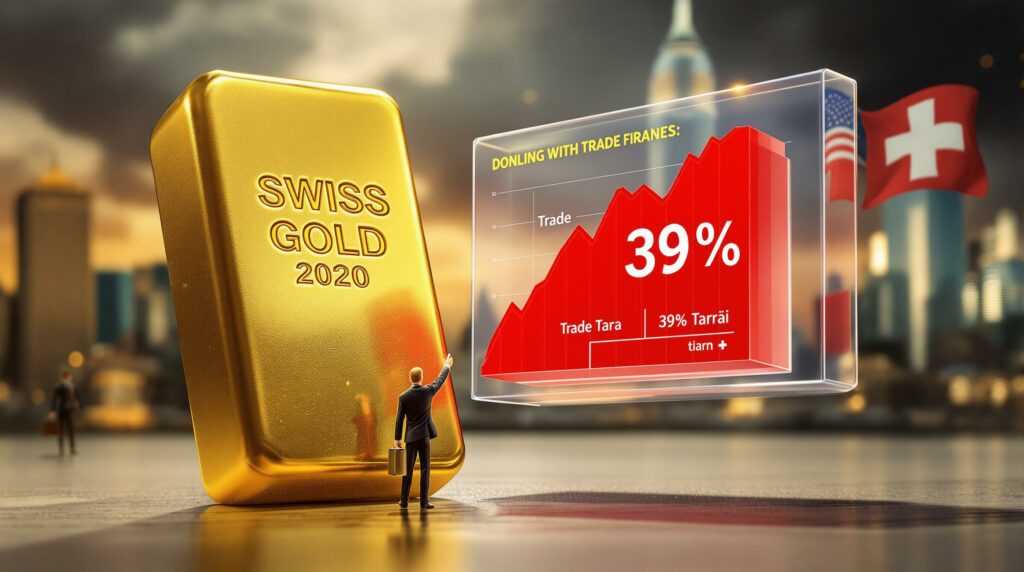The Switzerland-US Tariff Dispute: Gold Industry Caught in the Crossfire
Switzerland continues intense negotiations with the United States as newly implemented 39% import duties threaten billions in trade, with the gold industry particularly vulnerable. The high-stakes discussions, led by Helene Budliger Artieda of the State Secretariat for Economic Affairs (SECO), aim to reduce tariff rates that rank among the steepest applied under the current US administration's global trade realignment.
While the pharmaceutical sector has been spared, Switzerland's renowned gold refineries face an existential threat to their US exports worth nearly $10 billion annually. Industry leaders warn that the tariffs will completely halt gold bar shipments to America, disrupting longstanding trade relationships and potentially costing thousands of Swiss jobs.
What Are the Current Tariff Talks Between Switzerland and the US?
Overview of the Ongoing Tariff Discussions
The Swiss delegation continues working diligently in Washington to reduce the newly implemented 39% import duties on Swiss goods. Helene Budliger Artieda, head of the State Secretariat for Economic Affairs (SECO), is leading these critical negotiations, which officially became urgent when the tariffs took effect on Thursday, August 7, 2025.
"Discussions with the United States are ongoing. The discussions have consistently focused on reducing the additional US tariffs," SECO stated in its communication with Reuters. These tariffs represent some of the steepest applied under the current US administration's global trade reset initiative.
Unfortunately, a previous diplomatic mission led by Swiss President Karin Keller-Sutter failed to secure more favorable terms, highlighting the challenging nature of these negotiations. According to recent reports from Switzerland, the Federal Council is preparing to release additional information on the situation.
Timeline and Next Steps in Negotiations
Technical-level discussions are scheduled to continue into next week, though no formal talks were planned for Friday according to Swiss sources. The ongoing negotiations may include Switzerland offering additional concessions to secure lower tariff rates.
SECO has maintained strict confidentiality regarding specific negotiation details, stating it "would give no further details on the talks, which could include further concessions Switzerland may offer the US in return for lower tariffs."
The Swiss delegation faces significant pressure to reach a resolution quickly as industries begin feeling the immediate effects of these steep tariffs and gold price forecast 2025 indicates potential market volatility ahead.
How Will These Tariffs Affect Switzerland's Gold Industry?
Potential Impact on Swiss Gold Exports
The implications for Switzerland's gold industry are particularly severe. Christoph Wild, president of the Swiss Association of Manufacturers and Traders in Precious Metals, delivered a stark assessment: "With a tariff of 39%, exports of gold bars will definitely be stopped to the US."
This statement reflects the devastating reality for a sector that exported gold bars worth 7.86 billion Swiss francs (approximately $9.7 billion) to the US in the previous year alone. Switzerland serves as the world's premier gold refining center, processing an astonishing 70% of globally produced gold annually.
Five Swiss refineries typically import gold bars and resize them specifically for the American market. With these operations now economically unviable under the new tariff structure, the entire supply chain faces disruption, potentially leading to record-breaking gold prices as market adjustments occur.
Gold Industry Concerns and Statements
The Swiss Association of Manufacturers and Traders in Precious Metals has expressed significant concern about the tariffs' impact on longstanding trade relationships.
"We are particularly concerned about the implications of the tariffs for the gold industry and the physical exchange of gold with the US, a long-standing and historical partner for Switzerland," said Christoph Wild, highlighting the historic partnership between the two nations in gold trading.
A particularly troubling development is that previously exempt gold bars (1 kg and 100 oz) are now subject to country-specific tariffs. This policy change threatens Switzerland's dominant position in the global gold refining sector, potentially redirecting billions in trade to alternative markets or refineries, with significant implications for tariffs and gold investment strategies worldwide.
What Broader Economic Consequences Could Switzerland Face?
Projected Job Losses and Industry Impacts
The economic fallout extends far beyond the gold industry. Hans Gersbach, an economist from the KOF Economic Institute at ETH, estimates potential job losses between 7,500 and 15,000 across various sectors.
"The effect will be severe in some industries like watches, machinery and precision instruments. If pharma was also targeted, the figure would be higher," Gersbach explained. This assessment highlights the particularly vulnerable sectors: watches, machinery, and precision instruments.
The pharmaceutical sector, representing half of Swiss exports to the US last year, has been excluded from the tariffs—a silver lining in an otherwise challenging scenario. Major pharmaceutical companies like Roche and Novartis remain unaffected by the current tariff structure, preventing an even more devastating economic impact.
Business Adaptation Strategies
Swiss companies are actively exploring various options to navigate these tariff challenges. Potential strategies include price increases for US-bound products, accepting reduced profit margins, and production relocation to countries with more favorable tariff arrangements.
Some manufacturers are considering shifting production to European countries or Britain, which face lower US tariffs. This strategic realignment could fundamentally alter Switzerland's industrial landscape and employment patterns.
The business association economiesuisse has already conducted seminars to help companies develop coping strategies. These sessions focus on identifying alternative markets, adjusting production locations, and reconfiguring supply chains to minimize tariff impacts.
How Do These Tariffs Fit Into Broader US-Switzerland Trade Relations?
Historical Context of Bilateral Trade
Switzerland has traditionally maintained strong trade ties with the United States, with the gold industry representing a significant component of this longstanding commercial relationship. The current tariff situation represents an unexpected challenge in what has typically been a positive economic partnership.
"We still have difficulties understanding this friendly fire, but we are working on ways to cope with it," explained Jan Atteslander, economiesuisse board member. This characterization of the tariffs as "friendly fire" underscores the surprising nature of these trade restrictions between historical allies.
Swiss companies have historically dealt with challenges from an appreciating Swiss franc, which makes exports more expensive. This currency-related pressure has forced Swiss businesses to focus on innovation and quality rather than competing on price alone.
Comparison with Other International Trade Measures
The 39% tariff rate stands among the highest imposed under the current US administration's trade policies. This targeted approach affects specific Swiss industries while exempting others like pharmaceuticals, creating an uneven impact across the Swiss economy.
The situation represents part of a broader pattern of US trade policy adjustments with various trading partners around the world. However, the magnitude of these particular tariffs has raised concerns about proportionality and long-term economic consequences, as detailed by The Guardian in their coverage of the market reaction.
"Our companies are always under heavy pressure, so the only way to survive is to innovate," noted Atteslander, highlighting the resilience and adaptability that Swiss businesses must demonstrate in this challenging environment.
What's Happening in the Global Gold Market as a Result?
Market Reactions and Price Movements
The tariff announcement has triggered significant disruptions in global gold markets. Gold futures have seen notable price movements in response to the tariff situation, with New York gold futures developing a premium of more than $100 an ounce over the London Benchmark.
This substantial price differential reflects market participants' concerns about potential supply disruptions and their efforts to adjust trading strategies to account for the new tariff landscape. Recent gold price highs analysis suggests this trend may continue as markets adjust to the new reality.
The disruption in physical gold flow between Switzerland and the US could reshape traditional market dynamics, potentially creating new pricing models and trade routes for this critical commodity.
Alternative Supply Chain Considerations
US gold importers will likely seek alternative sources to replace Swiss supplies. This necessity creates both challenges and opportunities across the global gold market.
Refineries in other countries could potentially increase capacity to serve the US market, with operations in countries not subject to similar tariffs positioned to gain market share. Countries with established refining capabilities but lower market share may view this as an opportunity to expand their presence in the US market.
The restructuring of gold supply chains may create opportunities for emerging refining centers in Asia, North America, and other regions. However, replicating Switzerland's renowned quality standards and efficiency presents significant challenges for alternative suppliers.
Long-term implications for global gold trade patterns remain uncertain as markets adjust to this new reality. The coming months will reveal whether these changes represent a temporary disruption or a permanent reconfiguration of global gold flows, with important implications for investors seeking gold safe haven insights.
FAQs About the Switzerland-US Tariff Situation
Why Has the US Implemented These Tariffs on Switzerland?
The tariffs are part of a broader trade policy adjustment by the US administration. While specific justifications for targeting Switzerland haven't been fully detailed, they align with a pattern of revising trade relationships with various global partners to address perceived imbalances in bilateral trade.
The exclusion of pharmaceuticals suggests a targeted approach rather than a comprehensive rejection of Swiss imports, potentially indicating specific concerns about certain sectors or trade practices.
Which Swiss Industries Are Most Affected by the New Tariffs?
The watch industry, machinery manufacturers, precision instrument makers, and the gold refining sector are among the most severely impacted. These industries face the full 39% tariff rate, making their products significantly less competitive in the US market.
The pharmaceutical industry, which constitutes approximately half of Swiss exports to the US, has been excluded from the current tariff structure. This exemption spares major companies like Roche and Novartis from what would have been devastating financial consequences.
Could These Tariffs Lead to Retaliatory Measures from Switzerland?
While no specific retaliatory measures have been announced, the ongoing negotiations suggest Switzerland is prioritizing diplomatic solutions rather than escalation. The focus appears to be on securing exemptions or reductions to the tariffs through continued discussions.
Switzerland's relatively small economic size compared to the US limits its leverage in trade disputes, making negotiation rather than retaliation the most practical approach. However, if negotiations fail, Switzerland may explore targeted responses within the framework of international trade agreements.
How Might US Consumers Be Affected by These Tariffs?
US consumers could potentially see price increases for Swiss-made products, including watches, precision instruments, and machinery. The 39% tariff will likely be partially passed on to consumers, reducing demand for these premium Swiss goods.
Additionally, changes in gold bar availability might impact investment options for precious metals buyers in the American market. With Swiss refiners potentially exiting the US market, investors may face fewer choices or altered specifications in available gold products.
Financial institutions and wealth managers handling physical gold investments will need to adjust their procurement strategies and potentially revise client recommendations based on changing availability and pricing.
Navigating Uncertain Waters: The Future of Swiss-US Trade Relations
The current tariff dispute represents a critical juncture in the longstanding trade relationship between Switzerland and the United States. While negotiations continue, businesses on both sides are preparing for a potentially transformed trade landscape.
For the gold industry in particular, these tariffs could redraw the map of global gold refining and trading. Switzerland's historical dominance in this sector faces an unprecedented challenge, with potential ripple effects throughout international precious metals markets.
As Swiss negotiators work to secure better terms, businesses must simultaneously plan for both resolution and adaptation. The coming weeks will reveal whether diplomacy can prevail or if these tariffs will permanently alter the economic relationship between these traditionally close trading partners.
Note: This situation continues to evolve rapidly. Readers are encouraged to follow updates from official sources including the Swiss State Secretariat for Economic Affairs (SECO) and relevant US government agencies for the latest developments.
Interested in Capitalising on Major Mineral Discoveries?
Explore Discovery Alert's proprietary Discovery IQ model that delivers real-time notifications on significant ASX mineral discoveries, providing you with actionable insights before the broader market. Visit our discoveries page to see how historic mineral discoveries have generated substantial returns for early investors.




